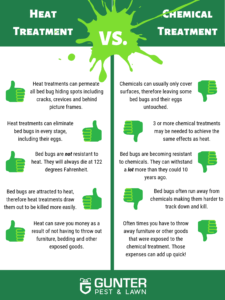5 Easy Facts About Bed Bug Services Described
Table of ContentsNot known Details About Bed Bug Services How Bed Bug Services can Save You Time, Stress, and Money.Some Ideas on Bed Bug Services You Need To Know
Heat treatment is a highly effective ways for eradicating bed bugs from apartments, condos, and offices. Unlike pesticide applications that require repeated applications, thermal methods reaches all hiding spots, destroying bugs at every stage in a single session. Knowing how heat treatment functions can help homeowners, property managers, and business owners make informed decisions.The science behind heat treatment is straightforward but effective. Bed bugs cannot survive when sustained heat is applied. Studies show that heat above 122 degrees Fahrenheit destroy both adults and eggs. For thorough eradication, professionals usually raise the temperature higher so that even hard-to-heat areas reach lethal levels. Maintaining sustained heat makes sure that every hiding place is affected.

Facts About Bed Bug Services Revealed
When heaters are deployed, they bring in industrial-grade heaters along with air movers to move heat into hidden areas. Rather than rushing the temperature increase, the temperature is raised slowly, to protect belongings and reduces the chance of bed bugs escaping to cooler spots.

After the treatment, technicians shut down equipment and the area is brought back to normal temperatures slowly. Many companies check the property for remaining bed bugs and provide detailed reports showing that the her response process was thorough and successful. This documentation verifies effectiveness and proves the infestation was treated.
Heat treatment is preferred for many infestations. It is chemical-free, which is ideal for families and those with health concerns. It is often fast and efficient, allowing residents to return home quickly - Bed Bug Services. Heat also penetrates cracks, wall voids, and dense fabrics. Unlike some methods, the life cycle is fully eradicated, saving time and money
A Biased View of Bed Bug Services
While highly effective, heat treatment may not be perfect for every situation. It can be a higher upfront investment, particularly in multi-unit buildings. Reinfestation is possible if people bring them in again, so ongoing monitoring is important. Certain items may warp or melt under heat, and in multi-unit housing, follow-up monitoring is critical.
Many professionals follow heat with inspections and preventive measures to catch any stragglers. Follow-up devices and careful inspections can help verify the treatment’s success.
After treatment, proactive steps are important. Regular inspections of living spaces help prevent new infestations. Mattress and box spring look at here encasements make inspections easier, while keeping areas tidy can reduce the risk of recurrence. Being mindful of used items is also important to prevent bed bugs from returning.
Heat treatment remains the gold standard for challenging bed bug problems. It provides a fast, eco-friendly, and thorough solution that eliminates bed bugs in a single session. When managed carefully, it ensures complete eradication without the lingering effects of chemicals, allowing properties he said to be pest-free quickly.